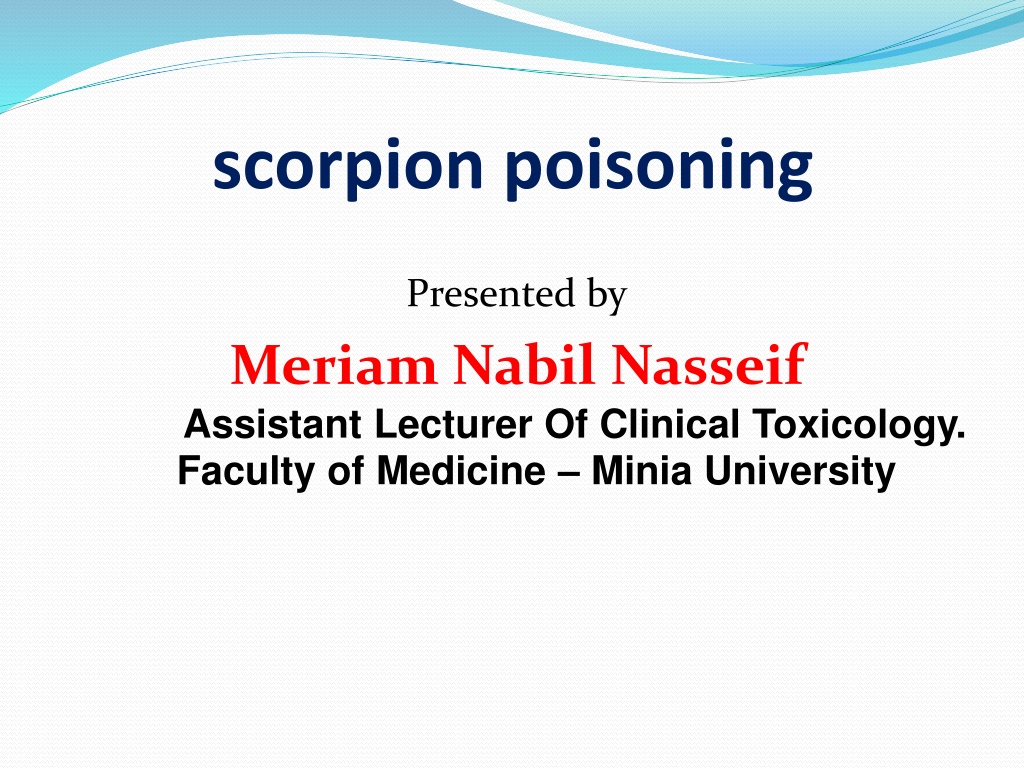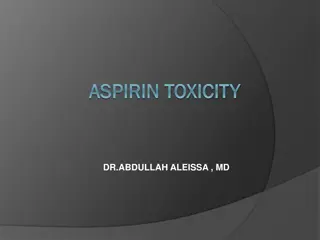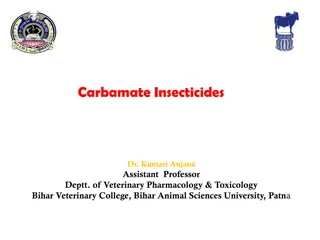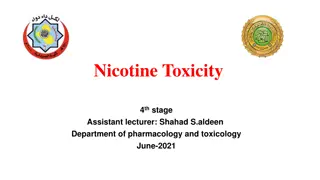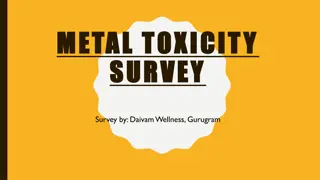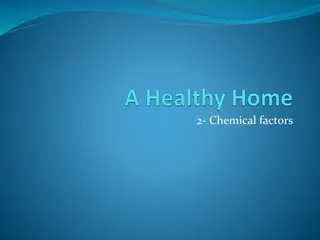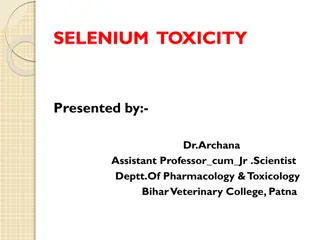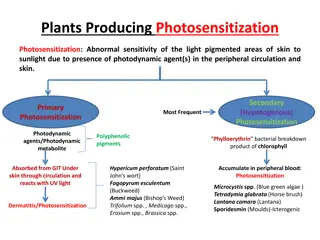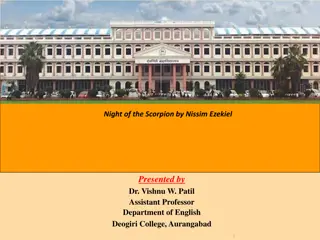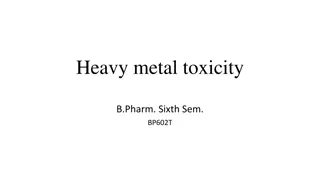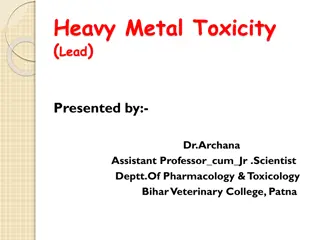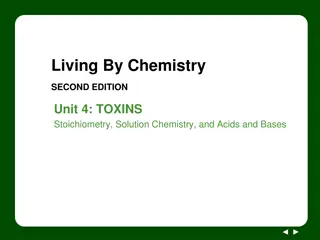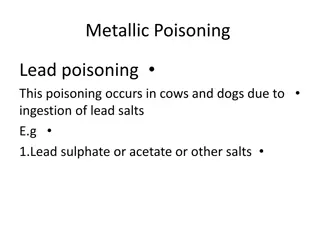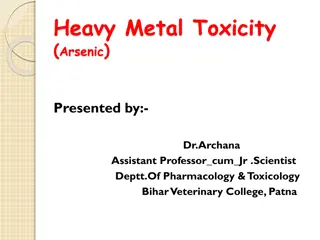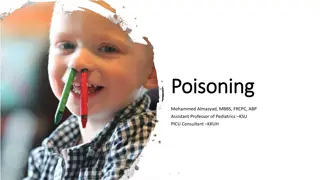Understanding Scorpion Poisoning: Composition, Toxicity, and Mechanism of Action
Scorpion poisoning is a serious issue presented by Meriam Nabil Nasseif, Assistant Lecturer of Clinical Toxicology at Minia University. This comprehensive guide explores the physical properties of scorpions, the composition of their venom, toxicity effects on the human body, and the intricate mechanism of action behind scorpion stings. From neurotoxic proteins to immune system responses, this insightful content sheds light on the complexities of scorpion venom and its potential impact on health.
Download Presentation

Please find below an Image/Link to download the presentation.
The content on the website is provided AS IS for your information and personal use only. It may not be sold, licensed, or shared on other websites without obtaining consent from the author. Download presentation by click this link. If you encounter any issues during the download, it is possible that the publisher has removed the file from their server.
E N D
Presentation Transcript
scorpion poisoning Presented by Meriam Nabil Nasseif Assistant Lecturer Of Clinical Toxicology. Faculty of Medicine Minia University
Introduction: - Scorpions are members of the order Scorpionida, and are the oldest and most primitive members of the phylum arachnids - They are nocturnal in nature and seek areas that are cool and moist. - They are not generally aggressive towards humans, but they do sting repeatedly when threatened or handled. - Physical properties: - Colour: differs from yellow, light brown, .., to black. - Length: ranges from 5 cm. to 15 cm. - Post-abdomen: is a long slender structure which resembles the tail, and is composed of 5 segments that end in a sting
Composition of scorpion venom: * Low molecular weight proteins: Mainly neurotoxic. * No or minimal enzymes: Phospholipase A2. * Free amnioacids: Tryptophan, histamine. Serotonin, ... etc.
Toxicity of Scorpion Venom a- Site of action The most potent toxin is the neurotoxin, and is responsible for causing cell impairment in nerves, muscles, and the heart (act mainly on excitable cells of nervesand muscles). b- Action 1- Central ----------malignant hyperthermia & convulsion. 2- Peripheral------direct & indirect a)*Direct i- stimulation of the heart ii- stimulation of alpha adrenergic receptors------ vasoconstriction, cold extremities, tachycardia, hypertension & pulmonary odema. b)* Indirect -------- stimulation of postganglionic fibers of both elements of autonomic nervous system and adrenal glands with release of catecholamines
Mechanism of action Scorpion stimulates neuro-endocrinal immunological axis. (1) Nervous system *Blocks the Ca activated (dependant) potassium channels. *Stabilization of voltage-dependent Na channels in the open position, leading to continuous, prolonged, repetitive firing of the somatic, sympathetic, and parasympathetic neurons . (2) Endocrinal system Release of excessive neurotransmitters such as epinephrine, norepinephrine and acetylcholine, evokes an autonomic storm . (
(3) Immune system - Venom release catecholamines, corticosteroids, kinins & PGs which induce release of immunological mediators as cytokines - Pro-inflammatory cytokines induce tissue injury, inflammatory response mediate complications of . N.B - Neurotoxins of scorpion venom content is highly lethal than neurotoxin of snake venom. .
The LD50 of some scorpion neurotoxins have been analyzed to be 10 fold morepotent than cyanide. - Venom deposited via the intravenous route can cause symptoms only 4-7 minutes after sting. - Peak tissue concentration reaches within 30 minutes. - Overall toxin elimination half-life of 4.2-13.4 hours through the urine
Clinical presentation: - The clinical course of envenomation can be divided into 4-grades as in the following scale: Grade I: Local pain or paraesthesia at the site of sting. Grade II: Pain or paraesthesia away from the site of sting. Grade III: One or more of the following systemic effects:
(1) General manifestations: 1- Sweating and cold extremities, despite trunkal hyperthermia. 2- Thirst, dehydration and fever up to 42 C (2) Neuropsychatric manifestation: 1- Cranial nerve dysfunction: - Blurred vision , disturbed eye movement and constricted pupils. - Dysphagia and excessive salivation. - Tinnitus and slurred speech
2-Neurologic dysfunction: - Involuntary movements and jerky motility. - Agitation, restlessness, and confusion. - Convulsions, altered conscious level, or coma. - Malignant hyperthermia.
(3) Cardiovascular manifestations: 1- Tachy arrhythmias & hypertension. 2- Heart failure, hypotension and circulatory collapse. 3- Cardiomyopathy & toxic Myocarditis, 4- E.C.G. changes: Depressed S-T segment & inverted T-wave (injury 5- Autonomic storm(initial transient parasympathetic stimulation followed by prolonged sympathetic stimulation pattern).
4) Respiratory manifestations: 1- Tachypnea & respiratory distress. 2- Rhonchi & crepitations. 3- Pulmonary edema: It may be cardiogenic or non-cardiogenic in origin. (5) G.I.T. manifestations: - Severe vomiting, diarrhea, and may be hematemsis.
6) Genitourinary manifestations: 1- Priapism: It is a very common finding in scorpion sting, but its exact mechanism is unclear. 2- Uterine contractions which may induce abortion
Grade IV: The patient has all of the above manifestations (local & systemic). Generally, the scorpion stings are dangerous in children (below 10 years) and in elderly (above 60 years) poor outcome: * Altered conscious level. * Seizures. * Shock or hypotension. * ECG changes. * Pulmonary edema. * Malignant hyperthermia.
Investigations: Routine investigations include the following * Complete blood count (C.B.C.) * Serum electrolytes (Na+, K+, Cl-, HCO3) * Arterial blood gases (A B.G ), * BUN & serum creatinine. * Serum enzymes (C.P.K., A.S.T., A.L.T.)
Treatment: [I] First-aid measures: [II] Definitive Therapy: (At hospital) in the form of: (1) No manifestations - Close observation for 3-4 hr is usually what is needed. (2) Life-threatening manifestations: * Ensure patent airway. * Endotracheal intubation & suction of the secretions. * Establish an I.V. line. * Cardio version (medical or electrical) in case of cardiac arrest or serious ventricular arrhythmias
3) Specific measures: (Antivenom) - It should be considered for: (i) Overt cases ( with clinical manifestations). (ii) After stabilization of life-threatening manifestations. - Dose: - Skin test (hypersensitivity) must be performed before the administration to avoid anaphylaxis. - Start with one ampoule I.M. - If there is no response within 0.5 - 1 hr., the dose can be repeated up to 3 ampoules I.M. - In severe cases 1-5 ampoules can be given by slow i.v. drip method.
Prazocin a) It is a physiological and pharmacologic antidote to the actions of scorpion venom. It is a competitive post-synaptic alpha1, adreno- receptor antagonist & should be the first line of management, since alpha receptors stimulation plays a major role in the evolution of clinical spectrum &
b) It is also cardioprotective as follow: 1- Suppresses sympathetic outflow 2- It decreases the preload, afterload and blood pressure without increasing the heart rate. 3- Activates venom-inhibited potassium channels. Dose The recommended dose is 30 microgram/kg/dose. (250-500 micg/3 hr)
Dobutamine 1- Victims who presented in due to both ventricular dysfunction, clinically characterized by (hypotension, shock, tachycardia, delirium with or without pulmonary edema and warm extremities), these cases improves with dobutamine infusion 5-20 microgram /kg/min. 2- In children with pulmonary edema with or without hypertension, management should be directed towards relieving afterload without compromising preload
(4) Symptomatic and supportive measures: 1- I.V. fluid replacement. 2- Antihypertensive drugs in case of severe hypertension Na nitroprusside 3- Vasopressors in case of shock (Dobutamine). 4- Treatment of arrhythmias according to its type. 5- Fresh blood transfusion in case of coagulopathy. 6- Pulmonary edema and/or hypoxia: Mechanical ventilation with positiveend expiratory pressure (PEEP). 7- Prophylactic antibiotics & antitetanic serum (toxoid).
